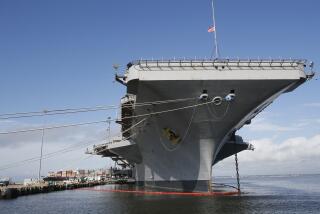Big Picture Could Play Role in Sub Crew’s Fate
- Share via
PEARL HARBOR, Hawaii — In concluding the Navy’s court of inquiry into the Greeneville submarine disaster, the president of the court promised that the panel’s findings and recommendations will be based solely on the testimony from 33 witnesses over 12 days.
But when the court’s report is forwarded to Adm. Thomas Fargo, commander of the Pacific Fleet, the rules change significantly.
Fargo, the final arbiter, need not confine himself to evidence presented during the hearing on the fatal crash that killed five adults and four teenagers aboard a Japanese fishing trawler. The admiral is free to consider big-picture issues in deciding what punishment, if any, should be meted out to Cmdr. Scott Waddle, the sub’s captain, and others, according to experts in military law.
Among the concerns that Fargo is likely to consider is what is best for the Pacific Fleet in coming decades and for national security. Another concern will be the continuing relationship between the U.S. and Japan, which Fargo has called the cornerstone of maintaining stability in the Pacific region.
“Not only can he consider such things, he really should,” said John Jenkins, retired rear admiral and former head of the Navy’s Judge Advocate General Corps. “As an area commander, he has a very different responsibility than three admirals sitting on a court of inquiry.”
The role of international relations and concern over possible damage to the morale of U.S. military personnel is the wild card in the Greeneville saga.
The Japanese public was outraged by the Feb. 9 collision between the nuclear-powered attack sub and the trawler Ehime Maru.
But public opinion polls suggest that the American public would not support a decision by Fargo to order courts-martial for Waddle and others.
Naval history suggests that the Navy rarely files criminal charges against officers involved in accidents at sea.
In his closing statement, Waddle’s civilian attorney, Charles Gittins, told the court’s three admirals that recommending a court-martial could harm the Navy.
“If you recommend court-martial under these circumstances, who are you going to get to be commanding officers?” Gittins asked. “. . . You’re going to have a tough time finding a c.o. [commanding officer] to serve in this Navy.”
John Peters, a retired submarine captain who watched the court of inquiry on closed-circuit television, said, “Every prospective c.o. and petty officer is watching this case. It will send a very large message to them.”
Fargo’s decision also will send a message to the Japanese. The tragedy has increased demands by some in Japan for the U.S. to begin withdrawing its military bases.
“For a very proud people, it’s agonizing for many Japanese to have American bases there more than half a century after World War II,” said Richard Feinberg, a professor in the Graduate School of International Relations and Pacific Studies at UC San Diego. “The submarine disaster just heightens that sense of resentment, even among top officials, although they rarely speak publicly about it.”
Fargo, who grew up in Japan, has said he convened the court of inquiry to provide the Japanese public with a complete examination of the crash. The tragedy has strained relations between the two former enemies turned military allies and trading partners.
Some of the cultural cross-currents of the Greeneville case were evident Tuesday when Japanese Prime Minister Yoshiro Mori arrived in Hawaii after a meeting in Washington with President Bush.
Accompanied by family members of those killed on the Ehime Maru, Mori visited the crash site off Diamond Head to lay a wreath.
But the prime minister also paid an official visit to the National Memorial Cemetery of the Pacific, where many U.S. veterans of World War II are buried, including some killed during the Japanese attack on Pearl Harbor on Dec. 7, 1941.
The court of inquiry--composed of Vice Adm. John Nathman, Rear Adm. Paul Sullivan, and Rear Adm. David Stone--is expected to take several weeks to prepare its report. By regulation, Fargo will then have 30 days to reject, accept or modify the report.
During five hours of testimony Tuesday, Waddle said he takes full responsibility for the deadly collision but also blames his crew for disobeying orders and not warning him of the proximity of the Ehime Maru.
The admirals offered a scalding critique of Waddle’s leadership style, particularly his failure to supervise sonar operators and his “hurry-up” orders that may have kept his crew from having enough time to track other ships in the area.
The Greeneville sliced into the Ehime Maru while executing a rapid-ascent maneuver to impress 16 civilian VIPs. The admirals indicated they want the Distinguished Visitors program changed to ban captains from doing dangerous maneuvers as demonstrations.
Fargo has the power to censure and demote officers and enlisted personnel in his command, effectively ending their careers. He also can refer one or more to a “show-cause” panel to explain why they should not be immediately ousted from the Navy.
A decision by Fargo to order a court-martial for Waddle or any other crew member could lead to a public trial, possibly preceded by the military equivalent of a grand jury hearing. On the final day of the court, Navy lawyers said charges against Waddle could be dereliction of duty, hazarding a vessel or negligent homicide.
John Allen Williams, military expert and political science professor at Loyola University in Chicago, said that Fargo will most likely weigh international relations and Navy morale in deciding the degree of punishment for Waddle and others.
“He can’t go beyond what the facts will support, but any set of facts can justify several levels of possible action,” Williams said. “In the Navy, the higher up you go, the more discretion you have, and an admiral is as high as it gets.”
More to Read
Sign up for Essential California
The most important California stories and recommendations in your inbox every morning.
You may occasionally receive promotional content from the Los Angeles Times.










